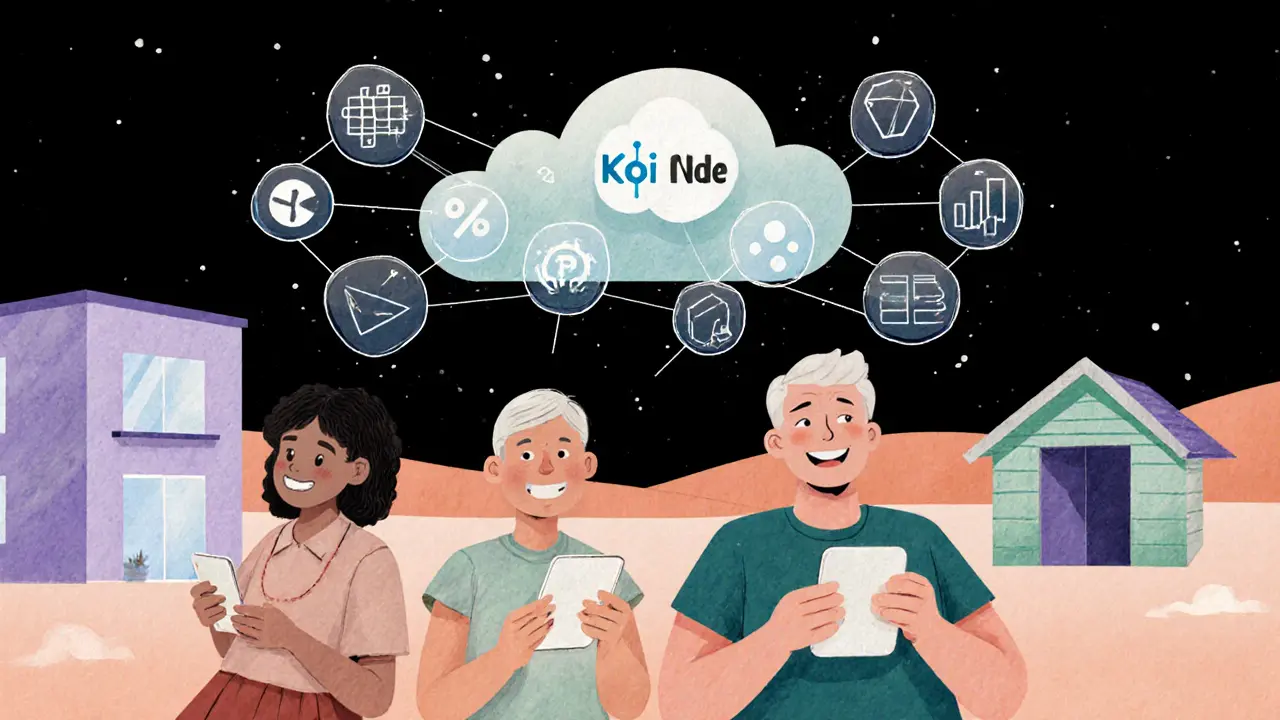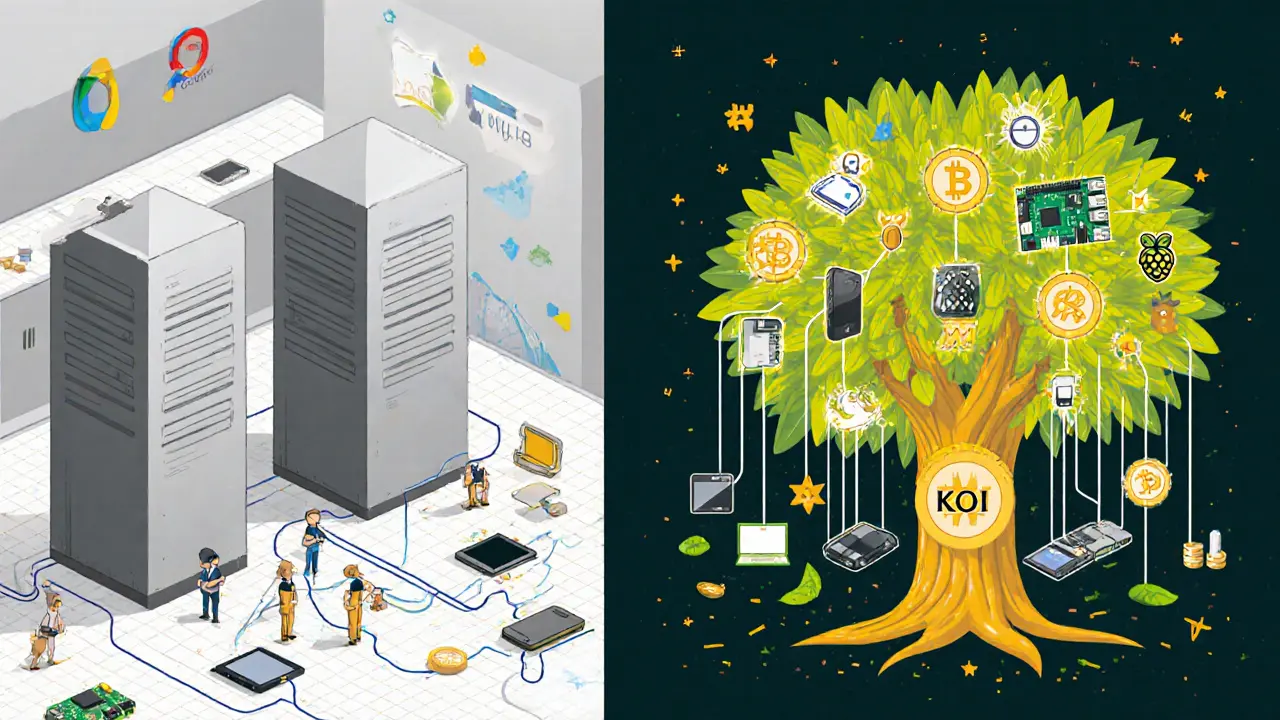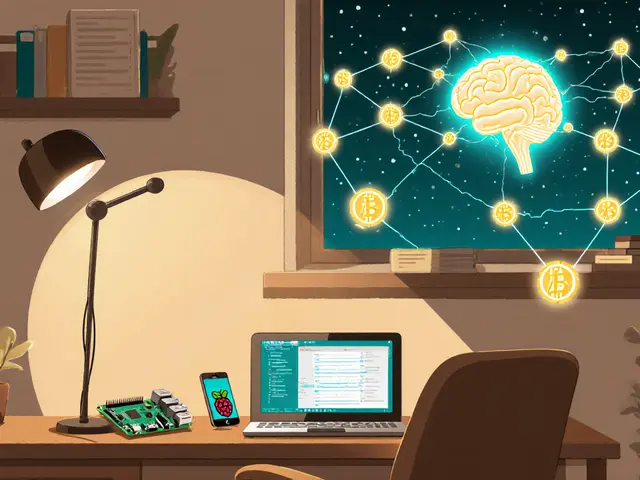Koii Node Earnings Calculator
Calculate Your Potential Earnings
⚠️ Earnings are highly variable and not guaranteed
When you hear "Koii (KOII)" mentioned in crypto circles, you might think it’s just another altcoin trying to ride the AI hype wave. But Koii isn’t trying to be another meme token or a copy of Ethereum. It’s building something far more unusual: a Koii network that turns your old laptop, Raspberry Pi, or even a spare smartphone into part of a global AI supercomputer. And you get paid in KOII tokens just for letting it sit idle.
Launched in late 2024, Koii’s mainnet is live. It’s not a theoretical project. Right now, it’s processing over 267,000 compute tasks every single day. That’s not a small number. It’s not Amazon Web Services-level traffic, but for a network built by everyday people running software on their personal devices, it’s significant. And it’s growing. Over 300 developers are actively building tools on top of it. More than 2,000 AI programs are already deployed and running on the network.
How Koii Actually Works (No Jargon)
Think of Koii like a decentralized Uber for computing power. Instead of drivers with cars, you have people with computers. When an AI developer needs to run a complex calculation - say, training a small image recognition model or checking data across thousands of sources - they send that task to the Koii network. The network finds the nearest available device (your laptop, your neighbor’s desktop, a server in Indonesia) and assigns the job. Once the task is done, the system verifies the result. If it’s correct, the device owner gets paid in KOII tokens.
You don’t need a gaming rig. You don’t need to be a coder. You just need a computer that can run the Koii Node software. That’s it. The app runs quietly in the background. It uses your unused CPU cycles. It doesn’t slow down your browsing or streaming. You can even run it on a $35 Raspberry Pi. And you earn tokens while you sleep, work, or watch TV.
Why Koii Is Different From Other Crypto Projects
Most crypto projects that talk about "decentralized computing" are either too technical or too vague. Koii cuts through the noise with two real innovations.
First, it’s the only DePIN network that lets any token be used to pay node operators. Most networks force you to use their native coin. Koii says: if you’re an AI startup and you want to pay people in your own token - say, $GPT or $VISION - you can. You don’t need to convert to KOII. You just issue your token on Koii’s platform, and the network handles the rest. That’s huge for developers. It removes a major friction point.
Second, Koii doesn’t just offer storage or bandwidth like other DePIN projects. It offers compute. Real, verifiable, on-demand processing power. This matters because AI isn’t just about data - it’s about doing math. And doing it fast, cheap, and distributed. Koii is betting that the future of AI doesn’t belong to a few big cloud companies. It belongs to millions of small devices working together.

Tokenomics: The Numbers Behind KOII
There are 10 billion KOII tokens total. That’s the max supply. It’s not inflationary. No new coins will be created beyond that.
But here’s where things get messy. The public sale happened in January 2025 at $0.0125 per token. That raised over $1 million. At that price, the project had a fully diluted valuation of $125 million. Sounds impressive, right?
Fast forward to November 2025. The price is around $0.000083. That’s a 99.3% drop from its all-time high of $0.0132 in January. The market cap is now roughly $930,000. For comparison, Render Network (RNDR), another DePIN AI project, has a market cap of $1.2 billion. Akash Network (AKT) sits at $500 million. Koii is a drop in the ocean.
Why the crash? Partly because the market turned bearish. Partly because early investors - who bought in at $0.0125 - are still locked up. Their tokens vest over 42 months. That means they can’t sell yet. But the public supply is flooding the market. And right now, there’s more selling pressure than buying.
Still, the tokenomics aren’t broken - they’re just slow. The team didn’t dump tokens. They locked them up. The community allocation? Only 5% released at launch, with the rest vesting over months. The foundation and ecosystem funds? Locked for 4-5 years. That’s actually responsible. It just means the price won’t bounce back overnight.
Is Koii Worth It? The Reality Check
Let’s be blunt: if you’re looking for a quick crypto flip, Koii is not it. The price is down. The sentiment is bearish. The RSI is at 30 - technically oversold, but that doesn’t mean it’s going up. The Fear & Greed Index says "Fear." Analysts are warning of more declines.
But if you’re thinking long-term - like, 3-5 years - Koii might be worth watching. Why?
- It’s not just speculation. It’s running real workloads. 267,000 tasks a day aren’t fake.
- It’s developer-friendly. Weekly updates. Webinars. Events like Koiihack at IIT Bombay.
- It’s solving a real problem: AI needs cheap, distributed compute. Big clouds are expensive and centralized.
- It’s built on actual tech, not hype. The K0 Testnet hit 1 million on-chain transactions. That’s proof of activity.
Compare it to Render Network. RNDR is bigger. More established. But it’s mostly used by professional studios. Koii is trying to reach the masses - the guy with an old MacBook, the student with a budget PC, the farmer in Nigeria with a solar-powered server. That’s a different kind of network. One that could scale faster if adoption grows.

How to Get Started With Koii
Getting started is simple. Go to koii.network. Download the Koii Node app. Install it. Log in. That’s it. You don’t need to buy KOII first. You earn it by running the node.
The app runs on Windows, macOS, Linux, and even Raspberry Pi. It uses less than 5% of your CPU when idle. No mining. No GPU strain. Just background processing.
Once you’re running a node, you’ll start earning KOII tokens. The amount depends on how much compute you contribute - how long your device is online, how much processing power it has, and how many tasks it completes. There’s no guaranteed payout, but the system is designed to reward consistent, reliable participation.
If you’re a developer? Join their Discord. Check out their webinars. Build an AI agent that uses Koii’s compute. You don’t need to be a genius. They’ve made it easier to deploy AI tools than ever before.
The Bigger Picture: Is This the Future of AI?
The AI race isn’t just about who has the biggest model. It’s about who has the cheapest, most distributed compute. Right now, OpenAI, Google, and Microsoft control most of it. That’s risky. What if one company decides to shut down access? What if costs rise? What if regulations block innovation?
Koii’s vision is radical: let anyone, anywhere, contribute to the world’s largest AI supercomputer. No permission. No gatekeepers. Just open access. If it works, it could break the monopoly of Big Tech in AI.
It’s a long shot. But history shows that the most disruptive tech often starts small, quiet, and ignored. Bitcoin wasn’t taken seriously at $0.01. Ethereum was called a "gimmick" at $2. Koii might be the same.
It’s not a sure thing. But if you believe AI should be decentralized - not owned by a handful of corporations - then Koii is one of the few projects trying to make that real.
Is Koii (KOII) a good investment?
Koii is not a traditional investment. It’s a long-term bet on decentralized AI infrastructure. The token price has dropped over 99% since its January 2025 peak. If you’re looking for quick profits, avoid it. But if you believe in a future where AI compute is owned by the public - not corporations - and you’re willing to hold for 3-5 years, then running a node and holding KOII could make sense. The project is active, has real usage, and is building something unique. But there’s no guarantee of price recovery.
Can I earn real money with Koii?
Yes, but not a lot - yet. You earn KOII tokens by running the Koii Node software on your computer. Right now, earnings are small: maybe a few cents per month on a standard laptop. But as the network grows and demand for compute increases, payouts could rise. Think of it like staking - you’re contributing resources and getting paid in crypto. It’s passive, but not lucrative at this stage.
Do I need to buy KOII to run a node?
No. You don’t need to buy any tokens to start. Just download the Koii Node app, install it, and run it. You’ll earn KOII tokens as you contribute compute power. You only need to buy KOII if you want to trade it, stake it, or use it to pay for services on the network.
How is Koii different from Render Network (RNDR)?
Render Network focuses on high-end GPU rendering for studios and designers. It’s professional-grade and expensive. Koii targets everyday devices - laptops, desktops, even Raspberry Pis - and focuses on general-purpose AI compute. Koii also lets developers pay node operators in any token, not just KOII. That’s a big flexibility advantage. Render is bigger and more established. Koii is smaller but more open and inclusive.
Is Koii safe to use?
The Koii Node software is open-source and runs locally on your device. It doesn’t access your files, cameras, or personal data. It only uses idle CPU cycles. The network verifies tasks using cryptographic proofs, so there’s no risk of malicious code being injected. As long as you download the app from the official website (koii.network), it’s safe. Always avoid third-party download links.
What happens if Koii fails?
If the Koii network shuts down, your node stops earning tokens. The KOII tokens you’ve earned will still exist on the blockchain, but they’ll lose value if no one wants to buy them. That’s the risk with any crypto project. The software is open-source, so technically, someone else could fork it and keep it alive - but that’s not guaranteed. Treat Koii like an experimental tech project, not a bank deposit.

Michael Brooks
Koii is quietly building something real. I run a node on an old MacBook Air. It barely uses any power, and I’ve earned about $1.20 in six months. Not life-changing, but it’s passive income that doesn’t require me to do anything. The real value isn’t in the tokens yet-it’s in the network effect. When more devs deploy AI tools here, payouts will rise. This isn’t a pump. It’s a slow burn.
Ruby Gilmartin
Let’s be honest-this is a graveyard. 99.3% drop? That’s not a correction, that’s a corpse. The team locked up their tokens? Big deal. Everyone else dumped theirs. The only people still holding are either delusional or scammers pretending to be early adopters. This isn’t DePIN. It’s DePanic.
James Ragin
The notion that a decentralized AI network can compete with AWS or Google Cloud is a dangerous fantasy. The United States built its technological dominance through centralized infrastructure, not scattered Raspberry Pis. This project is a symbolic rebellion against meritocracy-offering rewards to anyone with a device, regardless of skill, efficiency, or contribution. It’s not innovation. It’s egalitarianism masquerading as technology. The market has spoken: value requires discipline, not participation trophies.
David Billesbach
Did you know the Koii team has ties to a shadowy blockchain lab in Estonia? They’re not just building compute-they’re testing AI models that can manipulate social media sentiment. The 267,000 daily tasks? They’re not training image recognition. They’re fine-tuning deepfakes for political ops. And the token dump? That’s not market pressure-it’s a cover-up. They’re laundering influence through crypto. You think you’re earning pennies? You’re helping them destabilize democracies. Wake up.
FRANCIS JOHNSON
This is the future. Not the flashy, overhyped AI that’s locked behind billion-dollar firewalls. This is the quiet, beautiful future where your grandma’s old laptop helps train the next breakthrough in cancer research. 💪 I run Koii on my Raspberry Pi while I sleep. I don’t care if it’s $0.0001 or $10-I care that I’m part of something that gives power back to people. The big boys are scared because this isn’t about profit-it’s about freedom. Keep going, Koii. We see you. 🌍✨
BRYAN CHAGUA
I appreciate the depth of this breakdown. The tokenomics are indeed unusual-most projects burn or inflate, but Koii locked everything. That’s rare. The fact that 300+ devs are building on it means there’s real traction. The price is low, but utility isn’t priced in market cap alone. If you’re looking at this as a speculative asset, you’re missing the point. It’s infrastructure. Like electricity in the 1920s-nobody knew how valuable it would be until the grid expanded.
Atheeth Akash
Bro I just installed it on my old phone and it’s running cool no issues at all. I got like 2000 tokens in a week and I didn’t even try hard. This thing is legit man. If you got spare device just run it. No risk. Free money while you chill
Michael Faggard
Let’s clarify the technical architecture: Koii leverages a verifiable computing layer built on zk-SNARKs for task validation, which eliminates the need for centralized orchestration. The token-agnostic payment layer operates via ERC-1155 multi-token standards on their custom consensus mechanism, K0Chain. This is not just DePIN-it’s DePIN 2.0. The market cap doesn’t reflect the protocol’s composability potential. When AI agents start auto-deploying on Koii, the demand curve will spike. We’re in the pre-2017 Ethereum phase.
Andy Purvis
Some people are scared of this because it’s too simple. No mining rigs. No GPU farms. Just your laptop doing nothing and getting paid. That’s the whole point. The system doesn’t need to be flashy to be powerful. I think this could actually work. Not because it’s perfect, but because it’s honest. The tech is there. The people are there. The question is-are we ready to believe in it?
Douglas Tofoli
just ran the node on my windows pc and it worked first try lol. no idea what im doing but it says im contributing and i got a little notification that i earned 0.002 koii. cool. i think im part of the future now 😎
Michael Heitzer
People keep comparing Koii to Render Network, but that’s like comparing a bicycle to a Tesla. RNDR is for professionals who need teraflops. Koii is for the rest of us-the students, the retirees, the coders in their garage, the farmers in Kenya with solar panels. It’s not about competing with the giants. It’s about building an alternative ecosystem. The fact that you can pay in $GPT or $VISION? That’s the real innovation. This isn’t crypto. This is the new internet layer. And it’s already running 267k tasks a day. That’s not hype. That’s infrastructure. We’re witnessing the birth of something quiet, stubborn, and unstoppable.
Noriko Yashiro
Im not a techie but i read this whole thing and i think its actually kinda beautiful. People think crypto is just about getting rich. But this? This is about letting everyone help build the future. Even if you only have a broken phone. Even if you live somewhere no one cares about. You still matter here. I’m gonna install it tonight. 🌱
William Moylan
They say it’s safe but what if the node secretly uploads your browsing history? What if the ‘idle CPU’ is actually mining your keystrokes for behavioral profiling? And why is the team anonymous? Why no KYC? This isn’t decentralization-it’s a Trojan horse for surveillance capitalism. They’re using your device to build AI that tracks you. Then they sell your data to the government. The token is just bait. Don’t be fooled. Your laptop is a spy.